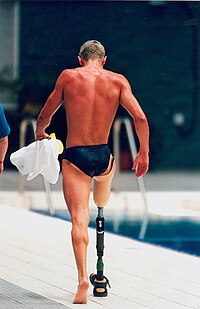
Photo from wikipedia
With the development of unstable footwear, more research has focused on the advantages of this type of shoe. This type of shoe could improve the muscle function of the lower… Click to show full abstract
With the development of unstable footwear, more research has focused on the advantages of this type of shoe. This type of shoe could improve the muscle function of the lower limb and prevent injury risks in dynamic situations. Therefore, the purpose of this study was to investigate differences in lower-limb kinetics and kinematics based on single-leg landing (SLL) using normal shoes (NS) and bionic shoes (BS). The study used 15 male subject volunteers (age 23.4 ± 1.14 years, height 177.6 ± 4.83cm, body weight (BW) 73.6 ± 7.02 kg). To ensure the subject standardization of the participants, there were several inclusion criteria used for selection. There were two kinds of experimental shoes used in the landing experiment to detect the change of lower limbs when a landing task was performed. Kinetics and kinematic data were collected during an SLL task, and statistical parametric mapping (SPM) analysis was used to evaluate the differences between NS and BS. We found that the flexion and extension angles of the knee (p = 0.004) and hip (p = 0.046, p = 0.018) joints, and the dorsiflexion and plantarflexion of ankle (p = 0.031) moment were significantly different in the sagittal planes. In the frontal plane, the eversion and inversion of the ankle (p = 0.016), and the abduction and adduction of knee (p = 0.017, p = 0.007) angle were found significant differences. In the horizontal plane, the external and internal rotation of hip (p = 0.036) and knee (p < 0.001, p = 0.029) moment were found significant differences, and knee angle (p = 0.043) also. According to our results, we conclude that using BS can cause bigger knee and hip flexion than NS. Also, this finding indicates that BS might be considered to reduce lower-limb injury risk during the SLL phase.
Journal Title: International Journal of Environmental Research and Public Health
Year Published: 2021
Link to full text (if available)
Share on Social Media: Sign Up to like & get
recommendations!